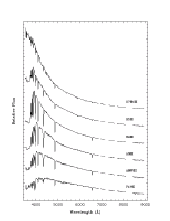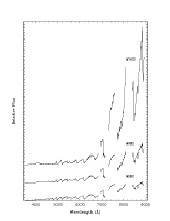Since the light from galaxies represents the integrated contribution of its
consitutient stars, then we can learn about stellar populations in galaxies
by modelling their light by summing up individual stellar spectra for different
kinds of stars. Here, from the Ph. D. thesis of David Silva , are spectra of
certain kinds of stars. The data cover the wavelength range 3500 - 9000 angstroms.
All of the relevant technical details about this data can be found in the Astrophysical
Journal paper by Silva and Cornell (1992)
There are currently about 30 different spectral types available. Note that
the designation V means main sequence, IV means subgiants, III means giants,
I means supergiant.
 |
A9 - O5 main sequence stars. These are hot stars, with
surface temperatures greater than 10,000 K. As a consequence their spectra
are rising into the blue. You should also note the steady increase of the
strength of the hydrogen absorption lines. |
 |
K5 - F7 main sequence stars. Now we see a progression
from stars with temperatures around 7000 (F7) to those with temperatures
of around 4000 (K5). The strength of the hydrogen lines decreases as collisional
excitation in these cooler atmospheres is insufficient to populate excited
stats in hydrogen. Metallic lines now become much stronger. In particular,
Calcium II H and K (wavelength around 3900 Angstroms), Magnesium I (5150
angstroms - see especially K stars) and Sodium D around 5800 angstroms.
As you get to lower temperature proportinately more flux is emitted at longer
(redder wavelengths). |
 |
G8 - A7 main sequence stars. Here we see a narrower
range of temperatures represented with again the general trend of increasing
metallic line strength and decreasing hydrogen line strength. A collection
of absorption features, predominately due to Iron, produces a depression,
known as the G-band around 4100 angstroms which can be clearly seen in the
G-star spectra (try using the zoom option in ghostview for this). |
 |
Blue Giants. Here are examples of massive stars as
they appear when they begin to evolve off the main sequence and head to
the red giant branch (movie of this not yet available). Not the extremely
well-defined hydrogen absorption lines. As the star expands its surface
gravity decreases, relative to what it was on the main-sequence, and this
improves the sharpness of the asbsorption lines. |
 |
Red Giants. Here are example spectra of cool, red giant
stellar atmospheres. They look similar to their main sequence counterparts
of the same spectral type but again the features are sharper, most notably,
the calcium triple at around 8500 angstroms, in which all 3 lines of calcium
are much more prominent in Giants than main sequence stars. |
 |
Very Cool Giants. (Here are example spectra of very
cool (T < 3500 K) red giant stellar atmospheres. The degree of excitation
is so low here that molecules are able to form in these atmospheres. The
complex rotational and vibrational energy states of a molecule give rise
to depp absorption troughs (called bandheads) that occupy 1-300 angstroms.
Missing data in these spectra is due to calibration problems associated
with sky subtraction. |
 |
Extreme Molecular Band Heads. These are the coolest
known giants (and likely to be very rich in heavy elements). The bandhead
structure should be obvious, particularly longward of 7000 angstroms. They
look similar to their main sequence counterparts of the same spectral type
but again the features are sharper, most notably, the calcium triple at
around 8500 angstroms, in which all 3 lines of calcium are apparent. |
 |
Blue Supergiants. |